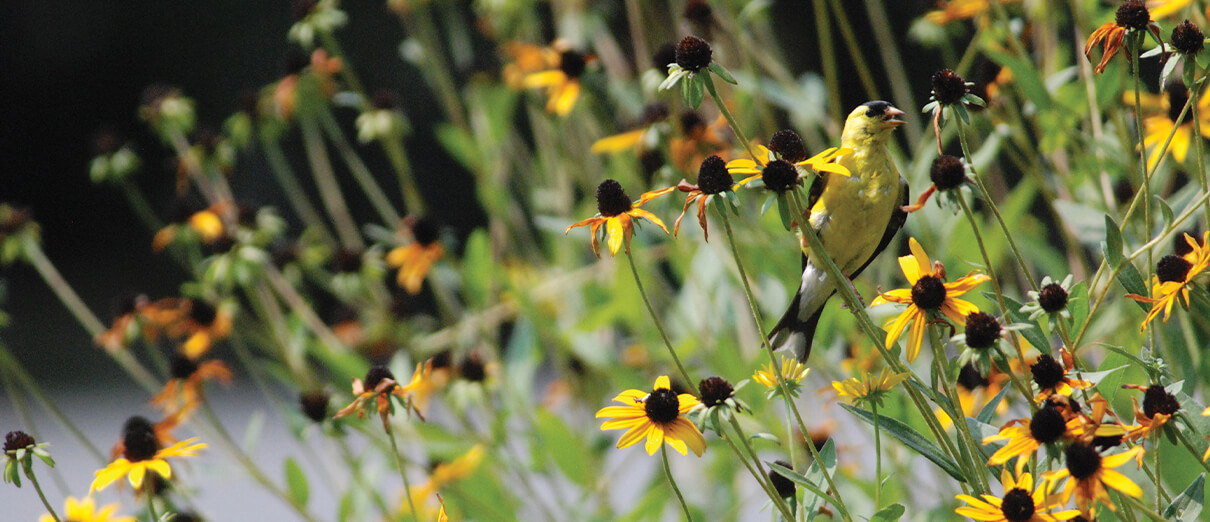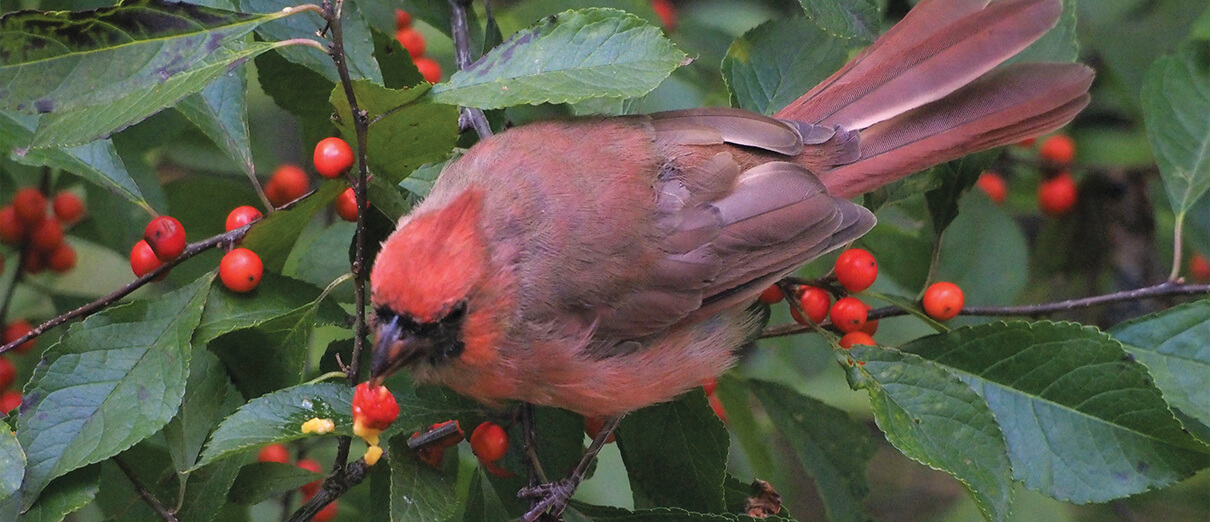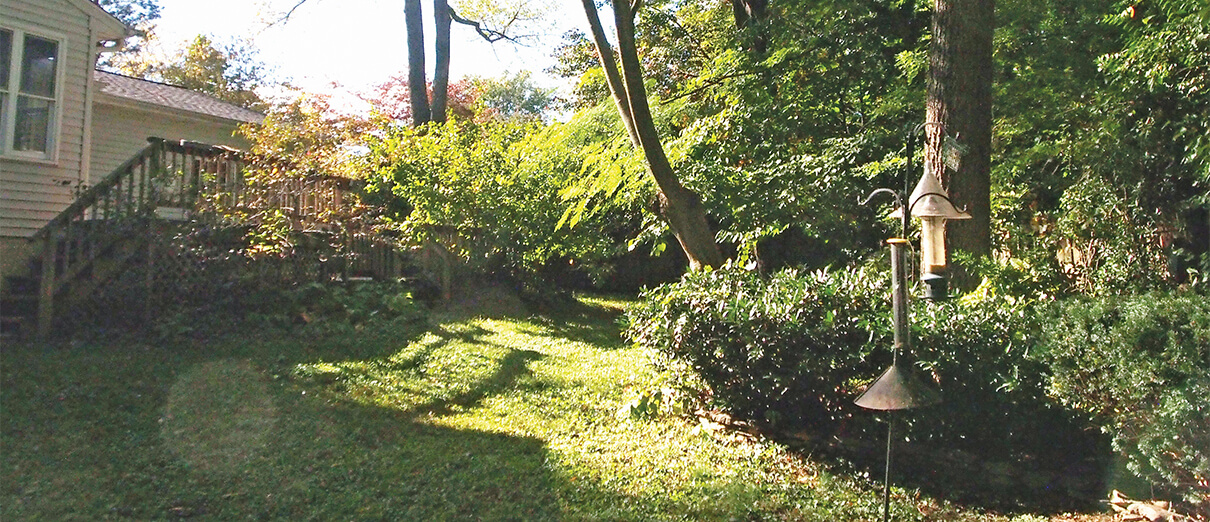ABC Birding: Home Edition
In our second “ABC Birding” installment, instead of taking readers to a birding site benefiting from ABC and partners' conservation efforts, we journey just out the door to highlight the experience of birding from home during a global pandemic, using my yard as an example.

An American Goldfinch feeds on Black-eyed Susan seeds by the author's driveway. Photo by Daniel J. Lebbin
Lay of the Land: Our home was built in the 1950s and sits on a third-of-an-acre of land in suburban Northern Virginia. My spouse and I moved here in 2009 and now have two young children. From our house, I can hear traffic from major commuting roads, including I-66. The front yard is dominated by a pesticide-free lawn, old maple trees, a Flowering Dogwood and an Eastern Redcedar. The back and side yards feature taller trees mainly along the property's edges, including Black Cherry, Black Walnut, and a Scarlet Oak. An emergent snag visible just outside the yard offers perches for woodpeckers and other birds. Undergrowth includes Sassafras, Eastern Redbud, Arrowwood Viburnum, Elderberry, and Spicebush. A bird bath and a seed feeder stocked with sunflower chips is visible from our inside dining area.
Focal birds: We have a typical assortment of backyard residents for eastern North America, including the Northern Cardinal, Song Sparrow, Carolina Wren, Carolina Chickadee, White-breasted Nuthatch, and Tufted Titmouse. All of these visit the feeding station. The American Goldfinch is another colorful yard star, present year-round, with males in bright canary-yellow plumage from roughly March to October. Summer breeders include the Gray Catbird, and winter brings White-throated Sparrows. We have a nice variety of woodpeckers year-round, including the Red-bellied, Downy, and, less frequently, the Hairy Woodpecker, as well as the Northern Flicker. The Pileated Woodpecker is largely absent, due to insufficient forest.
The yard list really builds when migratory birds pass through in spring and fall. Although I might normally see 15 to 20 species in a single day, there were a couple of epic migration days this past spring when I observed more than 40 species. This year, I have heard or seen more than 100 species from our property, including eight new yard birds, such as the Bobolink and Olive-sided Flycatcher — two declining species that ABC works to save with partners across the Americas.

A Northern Cardinal samples the Winterberry fruit out the back window. Photo by Daniel J. Lebbin
Other wildlife: A Red Fox or two patrols the neighborhood and our yard, keeping the Eastern Cottontails scarce. The Eastern Gray Squirrel is ubiquitous. Other mammals include the Eastern Chipmunk, White-tailed Deer, Common Raccoon, and Virginia Opossum. This year, I started using iNaturalist to identify insects, including large beautiful moths (such as the Imperial and Polyphemus), the Red-headed Bush Cricket, and black-and-
orange insects like the Large Milkweed Bug that favor a small patch of milkweed we planted.
When to visit: Our yard provides year-round interest, and no day is the same as the next. Yard birding regularly lets you learn the local birds and their habits, and provides more chances to find something unusual. Even just a few minutes can be productive. Morning and evening are the most active times. Evening skywatching can reveal birds flying high overhead to roosting sites — including waterbirds like Great Blue Herons — that are not likely to land in or near our yard. Midday can be eventful during hawk migration, after the ground warms and thermals rise.
Conservation Activities: Indoors, the house now hosts our home office, where I coordinate various ABC bird conservation activities from Hawai‘i to Brazil, and my spouse also works in conservation in Latin America, with both of us raising two wildlife-aware elementary school students. Outdoors, we have planted native plants that support wild birds and insects, and beautify our yard. Arrowwood Viburnum produces fruits gobbled up by the Gray Catbirds, cover for passage migrants like the Common Yellowthroat, and lacey white flowers attractive to bees. Trumpet (or Coral) Honeysuckle and Cardinal Flower (both native), and a (nonnative) Silktree attract Ruby-throated Hummingbirds in late summer. American Goldfinches feed on the seeds of Black-eyed Susans and Purple Coneflowers, which we leave up through the winter, even after the plants have died back. We also leave leaf-litter in the garden beds and in the dog pen; this provides substrate for foraging Brown Thrashers and occasionally Fox Sparrows that pass through on migration. We avoid using pesticides, and Northern Flickers love foraging for ants and other invertebrates on our lawn. We don't have cats (I am allergic), but our neighbors who do, keep theirs indoors. Neighborhood dogs and foxes keep other free-roaming cats away most of the time.

The author's yard. Photo by Daniel J. Lebbin
Directions: Whether you have your own yard or an apartment balcony, look out the window, and step outside if or when you can. I routinely upload my observations to eBird, so they can contribute to science and monitoring initiatives at larger scales, including breeding observations for the recent Breeding Bird Atlas project in Virginia. Modern tools available on your smart phone like eBird, Merlin, BirdCast, iNaturalist, and many others can help you get the most out of your nature observations or target key moments in the day or year to watch for birds.
I use BirdCast to alert me to large nocturnal migration events in my region, and this helps decide when to focus on morning birding during migration (or maybe stay in bed). It is also helpful for deciding when to go out in the middle of the night to listen for thrushes and other nocturnal migrants flying overhead. Between midnight and 1 a.m. on May 25 this past spring, I heard more than 100 Swainson's Thrushes call overhead in an hour, plus five Veery, and one Gray-cheeked Thrush.
Monitoring local birding channels (GroupMe texts, birding listservs, eBird alerts) provides real-time tips. For example, this past spring, Washington, D.C., birders were seeing Common Nighthawks overhead one evening, indicating a movement of this species. When I saw texts about this, I went outside and soon found my own nighthawk flying overhead after a few minutes. Usually, I may see only one or two each year from my yard. I got to see several flyover Common Loons one morning using this same method, and this species was new for the yard. It can also be helpful to join a group (like the DMV Yard/Patch Birders and Naturalists group on Facebook), start a friendly competition with neighbors or colleagues to list yard birds, and participate in a local Breeding Bird Atlas project. This might help motivate, inspire, and strengthen connections while being isolated at home during the pandemic.
For more information, see:
 | Daniel J. Lebbin is ABC's Vice President of Threatened Species. |


















































